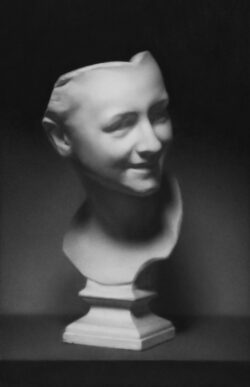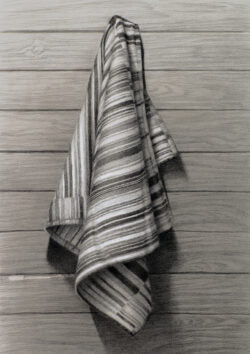Practice Makes The Creative Seeds Grow!
February 1, 2021
Getting Started with Mandy Boursicot

Coloured Chalk
We’re examining how to cultivate creativity by delving into the creative cycle. Last month, Danielle Krysa helped get us started through Re-Imagining and Experimentation. Now we’ve planted the seeds, it’s time to roll up our sleeves and get them sprouted – through plenty of practice, practice, practice!
But what do we do to get started?
This February, we’re extremely fortunate to have some expert guidance from Mandy Boursicot, a leading figure in the emerging Classical Realism movement. Trained in the Academic Method at the Angel Academy of Art in Florence, Italy, she now creates and teaches in her own private atelier in Vancouver.
Harvesting from her experience in drawing, Mandy runs us through the fundamentals of applied practice. She outlines a methodical approach to learning plus shares some handy tips for staying motivated and overcoming frustrations.
All this seasoned advice can be adapted for any medium. No matter what you’re working on, let’s make those creative endeavours flourish!

Boxing Gloves
Practice is the best way to learn, and learning anything meaningful requires dedication to your practice. If you’re just listening to a podcast or watching a video, you really only absorb five to ten percent. Even if you read a book, it’s not that much. The best way to learn is by doing! It’s only that kind of experiential training that will be retained by your brain and become part of your muscle memory. You should focus on good techniques and good habits, because if you practice bad habits, those will become ingrained.
I’m sure you know the idea that ten thousand hours of practice leads to mastery. In my case, it’s maybe more like thirty thousand hours, so it’s not just about learning as a beginner – it’s about maintaining one’s skills.
To progress from competence to mastery, you need to keep practicing.
When I talk about practicing, there are different steps at different stages of learning. Initially, you don’t really know anything, so you concentrate on very basic exercises. Once you have covered the fundamentals, you can focus on a particular item that you perceive as a personal weakness or have a desire to improve – that thing you don’t quite understand or can’t quite convey on a two-dimensional surface. That’s focused practice. It takes time to hone in on one element or skill. Of course, this also involves admitting that one has weaknesses, but pretty soon, after all that focused, persistent attention, it’s no longer a weakness – it might even become one of your strengths, because you applied it so much!
To follow the academic method of drawing, you start from copying from the flat – that is, someone else’s drawings. You then move on to drawing from 3D – something of a high relief, like a mask, hung on on a stand. The next step is depicting still life and then maybe a plaster figure, before finally progressing to a living object. Equally, you’re moving from the easiest medium, pencil, through to charcoal, learning to paint with charcoal, learning to paint with just black and white or monochrome brown and white, before graduating to a limited palette, and finally from a limited palette to a full palette.

At every stage there are challenges. Any time you advance from one medium to another – charcoal to oil, for example – there’s a big jump to something you’re not familiar with. It’s normal for frustration levels to soar as the quality of production plummets. One way to overcome this is to just be consistent, persistent and remind yourself that hundreds, if not thousands of other people have gone through the same difficulties. Trying to get to grips with a medium you don’t know how to control or use properly, or how to deal with models who breathe and don’t get back in the right position, is really hard!
It always helps to have someone more advanced – someone you trust, like a teacher or mentor – to steer you through those periods of intense (or mild) frustration.
My best advice is to take things slow. Spend enough time on any one stage to master it and feel really confident in your ability. It’s not a race. Set some time aside every day and devote that time to applied practice. You should just focus on the job at hand and not worry about the next stages, because you will get there eventually.

Towel in the Sauna
Before you can tackle more imaginative pursuits, you should work on naturalistic subjects, things that you see in real life. They provide an objective standard by which to measure your work: ‘Does it look like what it’s meant to look like?’, ‘Is it pleasing to the eye?’, or various other criteria like that.
Remember, by just being mindful and really observing your subject, observational drawing is an excellent way to build up your emotional reserves and capacity. As we navigate COVID, being shuttered up is taking a high mental and emotional toll on many of us. No matter what your level, drawing can be a wonderful healing practice during these difficult times.
 Mandy Boursicot
Mandy Boursicot
Mandy Boursicot has been a professional artist for 24 years, represented at prestigious Canadian galleries including Diane Farris, Buschlen-Mowatt, Agnes Bugera and The Wallace. She earned her BFA from Emily Carr University and later spent 4 years in Florence, Italy, where she mastered the Classical Realist method, and became the principal drawing instructor at the Angel Academy of Art. In 2012 she opened her private atelier in Vancouver BC, where she teaches drawing and painting. She has won many awards including BC Arts Council, Vancouver Parks Board, Art Renewal Center and Portrait Society of America.
For more information about Mandy Boursicot and her atelier, visit mandyboursicotatelier.com.
You can also follow Mandy on Instagram @mandy_boursicot_atelier

